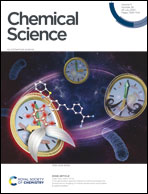Synthesis of the bis(cyclohexenone) core of (−)-lomaiviticin A†
Abstract
(−)-Lomaiviticin A is a complex C2-symmetric bacterial metabolite comprising two diazotetrahydrobenzo[b]fluorene (diazofluorene) residues and four 2,6-dideoxy glycosides, α-L-oleandrose and N,N-dimethyl-β-L-pyrrolosamine. The two halves of lomaiviticin A are linked by a single carbon–carbon bond oriented syn with respect to the oleandrose residues. While many advances toward the synthesis of lomaiviticin A have been reported, including synthesis of the aglycon, a route to the bis(cyclohexenone) core bearing any of the carbohydrate residues has not been disclosed. Here we describe a short route to a core structure of lomaiviticin A bearing two α-L-oleandrose residues. The synthetic route features a Stille coupling to form the conjoining carbon–carbon bond of the target and a double reductive transposition to establish the correct stereochemistry at this bond. Two synthetic routes were developed to elaborate the reductive transposition product to the bis(cyclohexenone) target. The more efficient pathway features an interrupted Barton vinyl iodide synthesis followed by oxidative elimination of iodide to efficiently establish the enone functionalities in the target. The bis(cyclohexenone) product may find use in a synthesis of lomaiviticin A itself.



 Please wait while we load your content...
Please wait while we load your content...